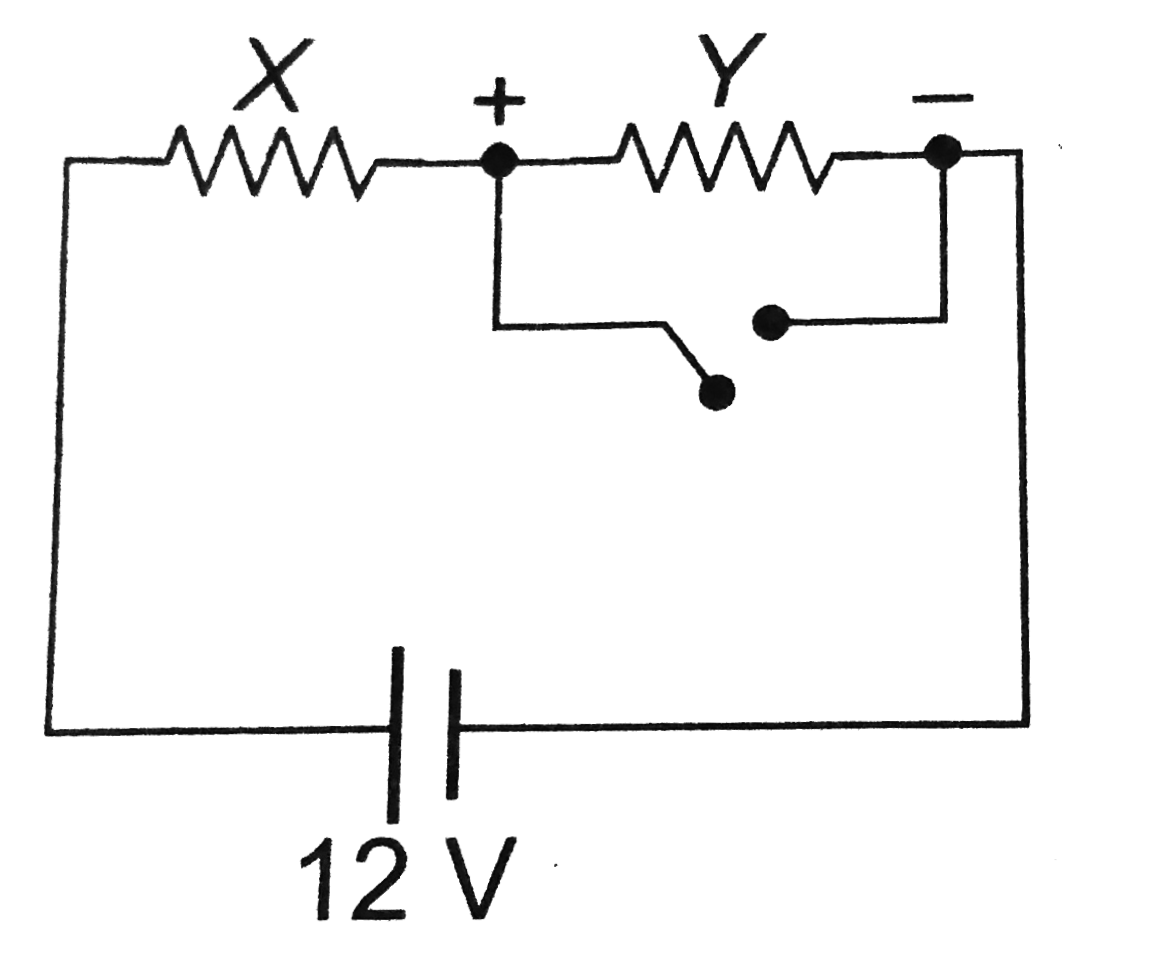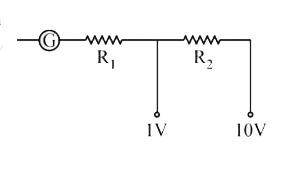The range of voltmeter is 10 V and its internal resistance is 50Ω. To convert it to voltmeter of range 15 V, how much resistance is to be added ?
Add 25Ω resistor in parallel
Add 25Ω resistor in series
Add 125Ω resistor in parallel
Add 125Ω resistor in series
The correct Answer is:B
To convert a voltmeter with a range of 10 V and an internal resistance of 50 Ω into a voltmeter with a range of 15 V, we need to follow these steps:
Step 1: Understand the basic principle of a voltmeter
A voltmeter is essentially a galvanometer with a resistance connected in series. The total resistance of the voltmeter determines the voltage range it can measure.
Step 2: Calculate the current through the galvanometer
The current (I) through the galvanometer when measuring 10 V can be calculated using Ohm's law:
I=VR=10V50Ω=0.2A
Step 3: Set up the equation for the new range
When we want to convert the voltmeter to a range of 15 V, we assume the current through the galvanometer remains the same (0.2 A). We can set up the equation:
I=VnewRnew
Substituting the values:
0.2=15Rnew
Step 4: Solve for the new resistance
Rearranging the equation to find Rnew:
Rnew=150.2=75Ω
Step 5: Determine the additional resistance needed
The original internal resistance of the voltmeter is 50 Ω. To find the additional resistance (R_add) needed to achieve the new total resistance:
Radd=Rnew−Roriginal=75Ω−50Ω=25Ω
Conclusion
To convert the voltmeter from a range of 10 V to 15 V, we need to add a resistance of 25 Ω in series.
---
A voltmeter is essentially a galvanometer with a resistance connected in series. The total resistance of the voltmeter determines the voltage range it can measure.
The current (I) through the galvanometer when measuring 10 V can be calculated using Ohm's law:
I=VR=10V50Ω=0.2A
When we want to convert the voltmeter to a range of 15 V, we assume the current through the galvanometer remains the same (0.2 A). We can set up the equation:
I=VnewRnew
Substituting the values:
0.2=15Rnew
Rearranging the equation to find Rnew:
Rnew=150.2=75Ω
The original internal resistance of the voltmeter is 50 Ω. To find the additional resistance (R_add) needed to achieve the new total resistance:
Radd=Rnew−Roriginal=75Ω−50Ω=25Ω
To convert the voltmeter from a range of 10 V to 15 V, we need to add a resistance of 25 Ω in series.
Topper's Solved these Questions
- CURRENT ELECTRICITYBOOK - DC PANDEY ENGLISHCHAPTER - CURRENT ELECTRICITYEXERCISE - Match the columns
4 Videos
- COMMUNICATION SYSTEMBOOK - DC PANDEY ENGLISHCHAPTER - COMMUNICATION SYSTEMEXERCISE - Subjective
11 Videos
- ELECTROMAGNETIC INDUCTIONBOOK - DC PANDEY ENGLISHCHAPTER - ELECTROMAGNETIC INDUCTIONEXERCISE - Medical entrances gallery
25 Videos
Similar Questions
Knowledge Check
The range of voltmeter of resistance 300Ω is 5 V. The resistance to be connected to convert it into an ammeter of range 5 A is
A1Ωin seriesB1Ωin parallelC0.1Ωin seriesD0.1Ωin parallelA galvanometer coil has a resistance of 15Ω and the metre shows full scale deflection for a current of 4 mA. To convert the meter into a voltmeter of range 0 to 18 V, the required resistance is
A5885Ωin seriesB4485Ωin seriesC5885Ωin seriesD4485Ωin series
A galvanometer of resistance 40Ω can measure a current of 10mA To convert it into a voltmeter of range 8V the required resistance is ___________ Ω.
View SolutionThe voltmeter shown in the figure reads 10V across 40 ω . The resistance of voltmeter is
View SolutionGiven that the resistance the voltmeter is 200Ω. Find the voltmeter.s reading.
View SolutionWhen an ammter of negligible internal resistance is inserted in series with circuit it reads 1A When the voltmeter of very large resistance is connected across X it reads 1V. When the point A and B are shorted by a conducting wire, the voltmeter meausres 10V across the battery. The internal resistance of the battery is equal to

View SolutionA battery of emf 1.4V and internal resistance 2Ω is connected to a resistor of 100ω resistance through an ammeter. This resistance of the ammeter is 4/3Ω. A voltmeter has also been connected to find the potential difference across the resistor.
a. Draw the circuit diagram.
b. The ammeter reads 0.02A. What is the resistance of the voltmeter?
c. The voltmeter reads 1.1V. What is the error in the reading?
View SolutionThe resisitance of a galvanometer is 50Ω and it shows full scale diflection for current of 1 mA. . To convert it into a voltmeter to measure 1V and as well as 10 V ( refer circuit diagram ) the resistance R1 and R2 respecivtively

View Solution
